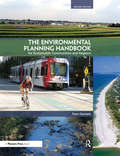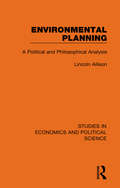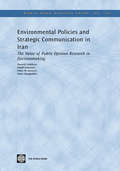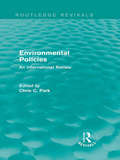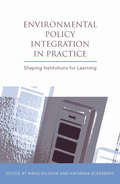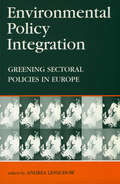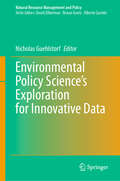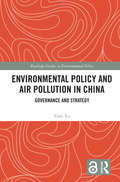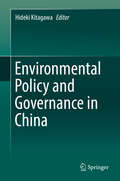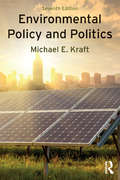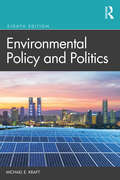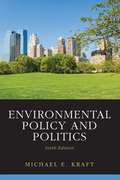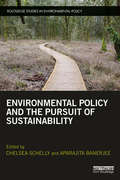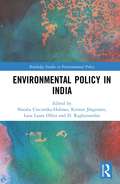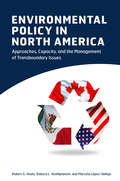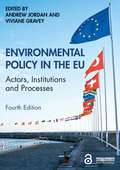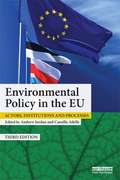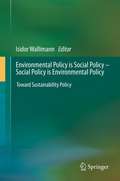- Table View
- List View
Environmental Planning Handbook
by Tom DanielsEnvironmental protection is a global issue. But most of the action is happening at the local level. How can communities keep their air clean, their water pure, and their people and property safe from climate and environmental hazards? Newly updated, The Environmental Planning Handbook gives local governments, nonprofits, and citizens the guidance they need to create an action plan they can implement now. It’s essential reading for a post-Katrina, post-Sandy world.
Environmental Planning in the Netherlands: From Command-and-Control Planning to Shared Governance (Urban Planning and Environment)
by Gert de RooThe Netherlands is one of the most prominent and innovative countries in the field of environmental planning. Over the past decade, its government has introduced such ground-breaking schemes as Integrated Environmental Zoning, the City-Environment Project, the Bubble Concept and Policy Concepts and new approaches to coping with noise, odours, soil pollution, air pollution and safety issues. These initiatives and policy tools reflect a rapidly changing and decentralising environmental policy, which contrasts with more conventional environmental ideologies. However, at present little is known of these policies in the international arena. De Roo shows how and why, in recent years, the country's planning system has moved away from its traditional 'top-down' structure. The resulting changes have had far-reaching consequences for the traditional principles of Dutch environmental policy. In addition, measures for compensating excessive environmental loads are now open to discussion and environmental quality is a subject of negotiation among stakeholders. All these developments mean that environmental policy-making has become more closely integrated with local initiatives that focus on general location-specific qualities. In this book, this development is referred to as 'tailor-made comprehensive planning', which relates closely to the local context, is area-specific, situation-dependent, and embraces shared governance.
Environmental Planning: A Political and Philosophical Analysis (Studies in Economics and Political Science)
by Lincoln AllisonOriginally published in 1975, this was an entirely new approach to the study of environmental planning and problems. Planning had hitherto been generally described as a technical exercise, involving the solving of biological and economic problems. In Environmental Planning: A Political and Philosophical Analysis it is seen as an ideological activity and the development of planning in Britain and the nature of contemporary environment problems are analysed in terms of social and political theory. The book discusses the nature of ‘planning’, its relationship to ‘politics’ and examines the groups and ideas which had been instrumental in its development. It tries to determine how important the environment is to people and how decisions affecting planning are made. In particular it looks at the theories and assumptions behind environmental policy, suggests alternatives and describes the role played by ‘participation’ and pressure groups in influencing planning in Britain at the time.
Environmental Policies and Strategic Communication in Iran
by Fabio Santucci Daniele Calabrese Elena Stanghellini Khalil KalantariAir pollution in Tehran has become a major problem in recent years, due to the geographical position of the town, industries, and traffic. Most private and public vehicles are old and have no emission control systems. The Municipality of Tehran and the Department of Environment have started several actions to reduce pollution, with communication activities being part of their strategy. For better planning, and to make possible the monitoring and evaluation of the communication activities, a baseline study was completed in 2004 using direct interviews of 1,200 Tehran residents. The interviews covered aspects such as experiences, opions, knowledge, and willingness to act. Use of and trust in several information sources and media were also investigated, in order to select the best communication mix for future activities.
Environmental Policies: An International Review (Routledge Revivals)
by Chris C. ParkThe importance of the effective management of the natural environment has become vital over the past few decades. In different countries, varying policies are implemented by governments to manage the environment, both to foster growth and reduce pollution and destruction. Employing a broad country-based approach, this edited collection, first published in 1986, surveys the growth, nature and effectiveness of the environmental management policies implemented by governments around the world. The overarching argument is that a coherent international approach is needed to deal with the problems surrounding environmental sustainability. This title will be of great value to students of the natural environment, sustainability and resource management.
Environmental Policy
by Jane RobertsEvidence of climate change, resource shortages and biodiversity loss is growing in significance year by year. This second edition of Environmental Policy explains how policy can respond and bring about greater sustainability in individual lifestyles, corporate strategies, national policies and international relations. The book discusses the interaction between environmental and human systems, proposing environmental policy as a way to steer human systems to function within environmental constraints. The second edition has been completely updated to reflect advances in scholarship (for example developments in governance theory) and the increasing primacy of climate policy within environmental policy as a whole. Key political, social and economic concepts are used to explain how effective environmental policies can be designed, implemented and evaluated. Environmental problems, the role of human beings in creating them and sustainable development are all introduced. Environmental policy formulation, implementation and evaluation are discussed within three specific contexts: the firm, the nation state and at an international level. The book reviews the relationship of economics, science and technology to environmental policy. It ends by reflecting upon the predicament of humankind in the twenty-first century and the potential of achieve sustainability through the use of the environmental policy ‘toolbox’. Environmental Policy is an accessible text with a multi-disciplinary perspective. Lively case studies drawn from a range of international examples – and completely updated for this second edition – illustrate issues such as climate change, international trade, tourism and human rights. It includes chapter summaries, suggestions for further reading and links to relevant web resources.
Environmental Policy (Routledge Introductions to Environment: Environment and Society Texts)
by Jane RobertsWithin the overall context of sustainable development Environmental Policy discusses the opportunities and constraints that environmental systems place upon the operation of human systems. It suggests environmental policy is a potential way to modify the operation of human systems so that they function within environmental constraints. Key social scientific concepts (political, social and economic) are used to explain the background for the formulation and implementation of environmental policy.Environmental problems, the role of humans in creating them, sustainable development and how this concept relates to environmental policy are all introduced. The book then considers environmental policy formulation, implementation and evaluation, within three specific contexts: the firm, the nation state and at the international level. It also reviews the place of economics, science and technology in environmental policy.Detailed case-studies, drawn from a range of international examples, are used throughout to illustrate issues such as global warming, international trade, tourism and the human rights of indigenous peoples. It is well illustrated and includes end of chapter summaries and further reading.
Environmental Policy Change in Emerging Market Democracies
by Jale TosunThis book examines environmental policy change in twenty-eight Central and Eastern European and Latin American countries against a background of significant political and economic transformation over the past two decades. Through cross-regional comparison and a multi-methods approach, Jale Tosun investigates changes in the regulation of air, soil, and water pollution, genetically modified corn, and the sustainable management of forests. Tosun also looks at the relationship between system transformation and the creation of environmental procuracies in both parts of the world.Environmental Policy Change in Emerging Market Democracies demonstrates that, although political and economic transformations have positively affected environmental policy in both regions, the extent of policy change varies considerably across Central and Eastern Europe and Latin America. At the same time, as Tosun argues, economic integration has acted as a major driver of a stronger governmental enforcement commitment as expressed by the creation of environmental procuracies.
Environmental Policy Integration in Practice: Shaping Institutions for Learning (Earthscan Research Editions Ser.)
by Måns Nilsson Katarina EckerbergEnvironmental values and concerns are meant to be reflected through environmental policy, which is then integrated into mainstream economic and social policy that serves to govern society and the economy in different sectors. Yet effective environmental policy integration has proved to be very difficult in practice and it remains largely an elusive aspiration. This groundbreaking volume presents the first ever detailed examination of EPI at the national policy level, focusing on the key sectors of energy and agriculture within Sweden, a country that is widely recognized as a front runner in environmental management. The authors deconstruct EPI, look at what it means in policy formation and examine how environmental priorities are treated in relation to other political priorities. The final section of the book lays out the major findings and presents key lessons for international application, including institutional recommendations on how to enhance the potential for EPI. Most fundamentally, the book answers the questions of what works for EPI, why it works, and how it can be achieved in practice across sectors. The result is a rich and indispensable guide for all those involved in environmental and sustainable development policy issues.
Environmental Policy Integration: Greening Sectoral Policies in Europe
by Andrea LenschowIntegrating environmental policies into the policies of all other sectors is the core European environmental policy. But there has been no thorough investigation of the political process involved. This volume provides the first. It analyses the process of policy integration - the greening of public policy - across the relevant sectors and countries. It finds significant variation from sector to sector and from country to country, and analyses the reasons for this. (Surprisingly the UK, traditionally the 'dirty man' of Europe is far more actively engaged than environmental 'progressives' such as Germany.) It identifies the obstacles to integration and offers solutions for policy formulation, decision making and implementation at the relevant political levels.
Environmental Policy Science’s Exploration for Innovative Data (Natural Resource Management and Policy #NA)
by Nicholas GuehlstorfThis edited volume discusses the use of nontraditional data sources in environmental political research and its implications for policymaking. Researchers involved in natural resource investigations and pollution control analysis must be entrepreneurial in finding and utilizing data sets to answer pressing policy questions. To remain relevant, successful researchers must increasingly seek data beyond routine federal program assessments, fragmented local surveys, and limited stakeholder interactions. This volume surveys current environmental research that draws on emerging data sources such as social media and political discourse. It poses critical questions about the potential of creative and innovative analytical approaches, particularly in contexts where policymakers have disregarded objective, evidence-based social science on environmental challenges. By encouraging scholars to adopt new methods, research designs, and data sources, this book offers valuable insights for researchers across the social and environmental sciences.
Environmental Policy Under Reagan's Executive Order: The Role of Benefit-Cost Analysis (Urban and Regional Policy and Development Studies)
by V. Kerry SmithFor the first time, a formal benefit-cost requirement plays an integral role in U.S. environmental policymaking, and in this volume, some of the nation's leading experts on environmental policy appraise the effects of President Reagan's Executive Order No. 12291. By considering how the Environmental Protection Agency has responded to 12291, these essays identify the limitations of conventional practices of benefit-cost analysis.Originally published in 1984.A UNC Press Enduring Edition -- UNC Press Enduring Editions use the latest in digital technology to make available again books from our distinguished backlist that were previously out of print. These editions are published unaltered from the original, and are presented in affordable paperback formats, bringing readers both historical and cultural value.
Environmental Policy and Air Pollution in China: Governance and Strategy (Routledge Studies in Environmental Policy)
by Yuan XuThis book systematically analyzes how and why China has expectedly lost and then surprisingly gained ground in the quest to solve the complicated environmental problem of air pollution over the past two decades. Yuan Xu shines a light on how China’s sulfur dioxide emissions rose quickly in tandem with rapid economic growth but then dropped to a level not seen for at least four decades. Despite this favorable mitigation outcome, Xu details how this stemmed from a litany of policy stumbles within the Chinese context of no democracy and a lack of sound rule of law. Throughout this book, the author examines China’s environmental governance and strategy and how they shape environmental policy. The chapters weave together a goal-centered governance model that China has adopted of centralized goal setting, decentralized goal attainment, decentralized policy making and implementation. Xu concludes that this model provides compelling evidence that China’s worst environmental years reside in the past. This book will be of great interest to students and scholars of Chinese environmental policy and governance, air pollution, climate change and sustainable development, as well as practitioners and policy makers working in these fields.
Environmental Policy and Governance in China
by Hideki KitagawaThis book focuses on how to create an environmentally friendly society in China from the viewpoint of environmental law and policy. The authors accessed a great number of valuable sources not available in English, and interviewed various scholars and public officials, in order to analyze the environmental policies in China while comparing some of the features to Japan. The book stresses the importance of introducing a brand-new policy of central and local government, and analyses why these policies have not been executed effectively in the local society. In addition to the economy-oriented policy and spirit of the Chinese nation, which are the main causes, this book also highlights shortcomings in the inspection system, information management, and the extremely low degree of public participation as important aspects to focus on in order to tackle the current problems. The individual chapters will help readers to understand the environmental issues in China in depth, and provide guidance on resolving the issues in China and in developing countries that are now or soon will be facing the challenge of combining economic growth and environmental improvement. Air, water and soil pollution are serious challenges in China. The deterioration of the environment often leads to rioting that influences social stability, which is also a great concern to foreign investors. This book will be of interest to a professional audience such as policymakers, journalists, members of environmental NGOs, managers and employees who do business with China, as well as academic researchers and students.
Environmental Policy and Household Behaviour: Sustainability and Everyday Life
by Patrik SöderholmOur behaviour in our own homes - our recycling habits, consumer choices and transport preferences - all have a huge impact on the environment locally and globally. Governments across the world are trying to formulate and implement policies to encourage and enforce more sustainable household actions. Yet so often these policies fail to have the desired effects because of a lack of understanding of the complex interplay of policy and individual behaviour. This book examines this interplay, looking at the role of values, attitudes and constraints in the links between policy and changing behaviour at the household level. The first part of the book explores the theoretical background looking at the politics of lifestyles and lifestyle change, policy legitimacy and barriers and facilitators for pro-environmental behaviour. The second part is made up of in-depth case studies from Sweden - one of the fore-running countries in this area - examining three main types of household behaviour: waste and recycling; consumption and labelling; and transportation choices. Within these case studies, the contributors examine what policy initiatives have and haven't worked and the role of values and constraints in those processes. This is the first inter-disciplinary, in-depth look at how environmental policy enters the private, domestic sphere. The theoretical insights and policy guidance the book offers will be vital in the drive to generate behaviour change at the household level and the move towards sustainable societies.
Environmental Policy and Politics
by Michael E. KraftCovering global threats such as climate change, population growth, and loss of biodiversity, as well as national, state, and local problems of environmental pollution, energy use, and natural resource use and conservation, Environmental Policy and Politics provides a comprehensive overview of U.S. policymaking processes, the legislative and administrative settings for policy decisions, the role of interest groups and public opinion in environmental politics, and the public policies that result. It helps readers understand modern environmental policy and its implications, including the need for a comprehensive and integrated approach to problem-solving. New to the Seventh Edition Each chapter includes the latest information about environmental challenges and governmental responses to them, with extensive citation of sources and websites that allow students to find the most recent studies and reports. Each chapter covers key political and policy decisions through early 2017, including presidential appointments, budgetary decisions, major legislative initiatives, and congressional actions. Each chapter introduction includes new statements about learning objectives to facilitate student understanding of key concepts and their applications, arguments advanced over environmental challenges and policies, and the goals and methods of environmental policy analysis. Chapters compare decisions about major environmental, energy, and natural resource policies among the presidential administrations of George W. Bush, Barack Obama, and Donald Trump, to the extent possible. Each chapter’s case studies have been changed or updated to include the latest developments and examples that should improve their appeal to students. These include controversies over the Keystone XL and Dakota Access pipelines, the EPA’s Clean Power Plan and new fuel economy standards, new policies on toxic chemicals, the role of environmental and energy policies in the 2016 elections, changes in the nation’s reliance on energy resources, standards for evaluating environmental and resource policies, and the Paris Agreement on climate change. Summaries of scientific studies, government reports, and policy analyses have been updated throughout the text to reflect the most current research and information in the field. All chapters include revised discussion questions and new suggested readings. The writing and flow of material have been improved throughout to make the chapters more accessible and useful to students.
Environmental Policy and Politics
by Michael E. KraftFor more than twenty years, Environmental Policy and Politics has kept instructors and students abreast of the challenges presented by contemporary environmental, energy, and natural resource problems in the United States. Now in its eighth edition, Michael E. Kraft has updated his definitive text to capture the changing nature of environmental problems as well as policy proposals made through 2020. Drawing from work within environmental science, policy analysis, and political science, this text continues to help readers think critically about how best to address problems through a variety of public policy tools and strategies at all levels of government. Important updates to this new edition include: • The latest information about environmental challenges and governmental responses to them, with extensive citation of key sources and websites. • Key political and policy decisions through late 2020, including presidential appointments, budgetary decisions, major legislative initiatives, and congressional actions. • New learning objectives to facilitate student understanding of key concepts and their applications, arguments advanced over environmental challenges and policies, and the goals and methods of environmental policy analysis. • Coverage of new topics that have emerged during the Trump presidency, including the Clean Power Plan repeal and reduction of environmental regulation, climate change, land conservation, changes in natural resources policies, and a comparison of the Republican and Democratic positions on climate change in 2020. • Updated summaries of scientific studies, government reports, and policy analyses. • Revised discussion questions and new suggested readings. Environmental Policy and Politics is an essential resource for upper level undergraduate and graduate students in political science and environmental studies looking for an accessible, well-researched, and up-to-date text, written with style and flair.
Environmental Policy and Politics
by Michael KraftCovering global threats such as climate change, population growth, and loss of biodiversity, as well as national, state, and local problems of environmental pollution, energy use, and natural resource use and conservation, Environmental Policy and Politics provides a comprehensive overview of U.S. policy-making processes, the legislative and administrative settings for policy decisions, the role of interest groups and public opinion in environmental politics, and the public policies that result. It helps readers understand modern environmental policy and its implications, including the need for a comprehensive and integrated approach to problem solving.
Environmental Policy and the Pursuit of Sustainability (Routledge Studies in Environmental Policy)
by Chelsea Schelly Aparajita BanerjeeIt is increasingly apparent that human activities are not suitable for sustaining a healthy global environment. From energy development to resource extraction to use of land and water, humans are having a devastating effect on the earth’s ability to sustain human societies and quality lives. Many approaches to changing the negative environmental consequences of human activities focus on one of two options, emphasizing either technological fixes or individual behavior change to reduce environmental harms through sustainable consumption habits. This book takes a different approach, focusing on the role of environmental policy in shaping the possibilities for and creating hindrances to pursuing more sustainable use of environmental resources. This unique compilation examines environmental policy through empirical case studies, demonstrating through each particular example how environmental policies are formed, how they operate, what they do in terms of shaping behaviors and future trajectories, and how they intersect with other social dynamics such as politics, power, social norms, and social organization. By providing case studies from both the United States and Mexico, this book provides a cross-national perspective on current environmental policies and their role in creating and limiting sustainable human futures. Organized around four key parts – Water; Land; Health and Wellbeing; and Resilience – and with a central theme of environmental justice and equity, this book will be of great interest to students and scholars of environmental policy and sustainability.
Environmental Policy in Europe: The Europeanization of National Environmental Policy (Environmental Politics #Vol. 7)
by Duncan Liefferink Andrew JordanThe continuing development of the European Union (EU) is transforming policy and politics in its member countries, and possibly in an even larger number of potential members. This book offers a detailed investigation of the Europeanization of national environmental policy in ten western European countries since 1970.By blending state-of-the-art theories with fresh empirical material on the many manifestations of Europeanization, it sheds new light on the dynamics that are decisively reshaping national environmental policy. It also offers an original assessment of how far Europeanization has produced greater policy convergence in western Europe.Throughout, the approach taken is genuinely comparative, drawing on the insights provided by leading country specialists.
Environmental Policy in India (Routledge Studies in Environmental Policy)
by Natalia Ciecierska-Holmes Kirsten Jörgensen Lana Laura Ollier D. RaghunandanThis book systematically introduces historical trajectories and dynamics of environmental policy and governance in India. Following the features of environmental policy in India as outlined in Chapter 1, subsequent chapters explore domestic and international factors that shape environmental policy in the country. The chapters examine the interplay between governmental and non-governmental actors, and the influence of social mobilisation and institutions on environmental policy and governance. Analysing various policy trajectories, the chapters identify and explore five central environmental policy subsystems: forests, water, climate, energy and city development. The authors drill down into the social, economic, political and ecological dimensions of each system, shedding light on why striking a balance between national economic growth and environmental sustainability is so challenging. Drawing on political science theories of policy processes and related theoretical concepts, this innovative edited volume will be of great interest to students and scholars of environmental policy and politics and South Asian studies more broadly.
Environmental Policy in North America: Approaches, Capacity, And The Management Of Transboundary Issues
by Robert G. Healy Debora L. VanNijnatten Marcela López-VallejoThis comprehensive analysis of key issues in North American environmental policy provides an overview of how the US, Mexico, and Canada differ in their environmental management approaches and capacity levels, and how these differences play into cross-border cooperation on environmental problems. The book offers insights into transboundary cooperation both before and after NAFTA, and presents a framework for making environmental interaction more effective in the future. The book is organized into two parts. The first, more general, section compares the national contexts for environmental management in each country—including economic conditions, sociocultural dynamics, and political decision-making frameworks— and shows how these have led to variations in policy approaches and levels of capacity. The authors argue that effective environmental governance in North America depends on the ability of transboundary institutions to address and mediate these differences. The book's second section illustrates this argument, using four case studies of environmental management in North America: biodiversity and protected areas, air pollution (smog); greenhouse gas reduction, and genetically modified crops.
Environmental Policy in the EU: Actors, Institutions and Processes
by Andrew Jordan Viviane GraveyThe European Union (EU) has a hugely important effect on the way in which environmental policies are framed, designed and implemented in many parts of the world, but especially Europe. The new edition of this leading textbook provides a state-of-the-art analysis of the EU’s environmental policies. Comprising five parts, Environmental Policy in the EU covers the rapidly changing context in which EU environmental policies are made, the key actors who interact to co-produce them and the most salient dynamics of policy making, ranging from agenda setting and decision making, through to implementation and evaluation. Written by leading international experts, individual chapters examine how the EU is responding to a multitude of different challenges, including biodiversity loss, climate change, energy insecurity, and water and air pollution. They tease out the different ways in which the EU’s policies on these topics co-evolve with national and international environmental policies. In this systematically updated fourth edition, a wider array of learning features are employed to ensure that readers fully understand how EU environmental policies have developed over the last 50 years and how they are currently adapting to the rapidly evolving challenges of the twenty-first century, including the COVID-19 pandemic. It is an essential resource for undergraduate and postgraduate students studying environmental policy and politics, climate change, environmental law and EU politics more broadly.
Environmental Policy in the EU: Actors, institutions and processes
by Andrew Jordan Camilla AdelleThe European Union (EU) has a hugely important effect on the way in which environmental policies are framed and implemented in many different parts of the world, but especially Europe. The new and comprehensively revised edition of this well-known textbook provides a state-of-the-art analysis of all the EU’s environmental policies. Comprising five parts, it covers the rapidly changing context in which EU environmental policies are made, the key actors who interact to co-produce policy and the most salient dynamics of policy making, ranging from decision making through to implementation and evaluation. Written by leading experts in the field, individual chapters examine how the EU is responding to a multitude of different problems including biodiversity loss, climate change, energy insecurity, and water and air pollution. They tease out the many important ways in which the EU's policies on these topics co-evolve with national and international environmental policies. In this third edition a mixture of learning features are employed to ensure that undergraduate and postgraduate students fully understand how EU policies in this vital area developed in the past and how they are now adapting to the rapidly evolving challenges of the twenty-first century.
Environmental Policy is Social Policy – Social Policy is Environmental Policy
by Isidor WallimannThis book argues that social and environmental policy should be synthetically treated as one and the same field, that both are but two aspects of the same coin - if sustainability is the goal. Such a paradigm shift is indicated, important, and timely to effectively move towards sustainability. This book is the first to take this approach and to give examples for it. Not to synthetically merge the two fields has been and will continue to be highly insufficient, inefficient and contradictory for policy and public administration aiming for a transformation towards a sustainable world. In general, social problems are dealt with in one "policy corner" and environmental problems in another. Rarely is social policy (at large) concerned with its impact on the environment or its connection with and relevance to environmental policy. Equally, environmental problems are generally not seen in conjunction with social policy, even though much environmental policy directly relates to health, nutrition, migration and other issues addressed by social policy. This book intends to correct the pattern to separate these very significant and large policy fields. Using examples from diverse academic and applied fields, it is shown how environmental policy can (and should) be thought of as social policy - and how social policy can (and should) simultaneously be seen as environmental policy. Tremendous benefits are to be expected.
